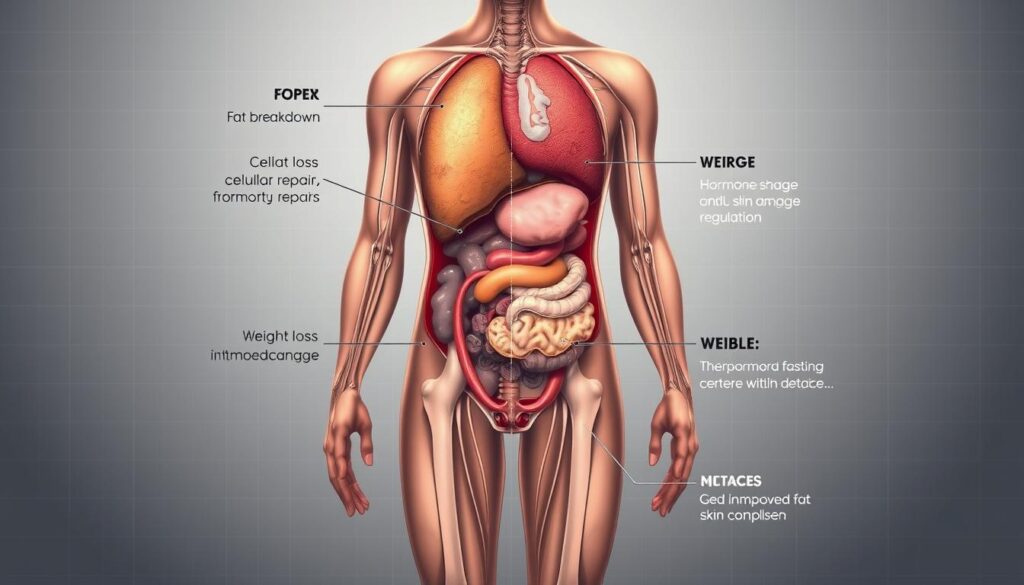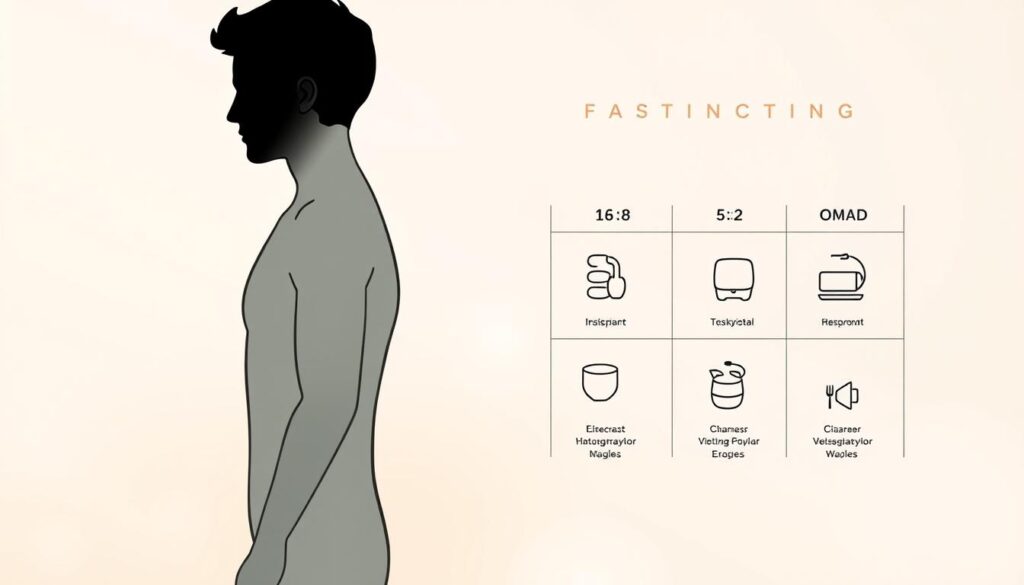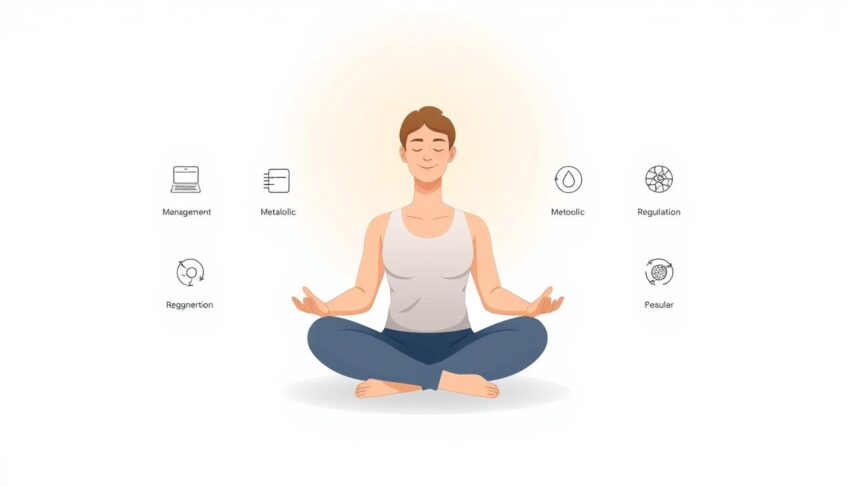Intermittent fasting has emerged as a popular health and wellness approach, cycling between periods of eating and fasting. It’s not a diet, but an eating pattern that focuses on when to eat rather than what to eat.
This approach has gained popularity due to its potential benefits for weight loss, metabolic health, and simplicity. Humans have evolved to be able to go without food for extended periods, making fasting a natural process for our bodies.
As a beginner, it’s essential to understand the basics of intermittent fasting and get practical tips to start safely. While research shows promising results, individual experiences may vary, and it’s crucial to find an approach that works for your lifestyle.
Key Takeaways
- Intermittent fasting is an eating pattern, not a diet.
- It has potential benefits for weight loss and metabolic health.
- Humans have evolved to be able to go without food for extended periods.
- It’s essential to understand the basics and start safely.
- Individual experiences may vary, and it’s crucial to find a suitable approach.
What Is Intermittent Fasting?
At its core, intermittent fasting is about changing when you eat, not what you eat. It’s an eating pattern that cycles between periods of fasting and eating. This approach doesn’t specify which foods you should eat but rather when you should eat them, making it more about the timing of your meals.

The Science Behind Fasting
When you fast, your body shifts from relying on glucose as its primary fuel source to burning stored fat, a process that can lead to weight loss and improved metabolic health. This change occurs because, during fasting periods, your body is forced to adapt to using different energy sources. Research and studies have shown that this metabolic switch can have various health benefits.
Fasting vs. Traditional Diets
Unlike traditional diets that focus on calorie restriction or specific food groups, intermittent fasting involves altering your eating pattern to achieve weight loss and other health benefits. Some people find it easier to stick to a regimen that restricts time rather than counting calories, making intermittent fasting a potentially more sustainable option for many.
The key differences between intermittent fasting and traditional diets include the focus on when you eat rather than what you eat, and the potential for greater flexibility and sustainability. By understanding these differences, individuals can make informed choices about their dietary approaches.
- Intermittent fasting is an eating pattern that alternates between periods of eating and fasting.
- It focuses on when to eat rather than what to eat, making it distinct from traditional diets.
- The science behind fasting involves a metabolic shift from glucose to stored fat as an energy source.
How Intermittent Fasting Affects Your Body
When you start intermittent fasting, your body undergoes significant changes at the cellular and molecular level. This complex process involves various physiological adaptations that can have a profound impact on your overall health.
Cellular and Hormonal Changes
During fasting, several key changes occur within your body. Human growth hormone (HGH) levels increase, while insulin levels decrease, making stored body fat more accessible. Your cells also undergo changes in gene expression, initiating important cellular repair processes. This includes autophagy, where cells digest and remove old and dysfunctional proteins, potentially leading to improved cellular function and longevity.

Metabolic Switching Explained
As you fast, your body exhausts its glucose stores and begins to burn fat for fuel, a process known as metabolic switching. This transition can lead to improvements in body composition and metabolic health. The timing and duration of fasting periods can influence these bodily responses, with different protocols producing varying effects. By understanding how intermittent fasting affects your body, you can better navigate the various methods and choose the one that suits you best.
Popular Intermittent Fasting Methods
There are several approaches to intermittent fasting, catering to different lifestyles and preferences. This flexibility is one of the reasons intermittent fasting has gained popularity, as individuals can choose a method that suits their needs.
The 16/8 Method
The 16/8 method, also known as the Leangains protocol, involves fasting for 16 hours and eating within an 8-hour window. This can be achieved by skipping breakfast or dinner, making it relatively easy to incorporate into daily life. For example, one might eat between 10 AM and 6 PM, and then fast from 6 PM to 10 AM the next day.
The 5:2 Diet
The 5:2 diet involves eating normally for five days of the week and restricting calorie intake to 500-600 calories on the other two non-consecutive days week. This method allows for flexibility in choosing which days to fast, making it easier to stick to.

Eat-Stop-Eat (24-Hour Fasting)
Eat-Stop-Eat involves fasting for a complete 24-hour period once or twice a week. For instance, one might stop eating at 7 PM on Monday and not eat again until 7 PM on Tuesday. This method is considered more advanced and should be approached with caution, especially for beginners.
Alternate Day Fasting
Alternate Day Fasting is a more extreme form of intermittent fasting, where one alternates between fasting periods (consuming zero or minimal calories) and regular eating days. While it can be effective, it may not be suitable for everyone, particularly those with certain medical conditions or beginners.
Each of these intermittent fasting methods has its own benefits and challenges. The key is to find a method that fits your lifestyle and can be maintained consistently over time. By choosing an appropriate eating window and fasting periods, individuals can tailor intermittent fasting to their needs, making it a sustainable long-term practice.
Health Benefits of Intermittent Fasting
The health benefits of intermittent fasting are multifaceted, ranging from weight loss to improved insulin sensitivity. By reducing the window in which you eat, you naturally consume fewer calories, which can lead to weight loss. Additionally, intermittent fasting affects hormone levels, including the increase of norepinephrine, a fat-burning hormone.
Weight Loss and Fat Burning
Intermittent fasting promotes weight loss through calorie reduction and hormonal changes that enhance fat burning. The increase in norepinephrine levels helps the body burn fat more efficiently. According to research, intermittent fasting can be a powerful tool for weight loss when done safely.
Improved Insulin Sensitivity
Fasting periods give the body a break from constant insulin production, potentially reducing the risk of type 2 diabetes. Improved insulin sensitivity is one of the significant health benefits of intermittent fasting, as it helps regulate blood sugar levels.
Other Potential Health Benefits
Other potential health benefits of intermittent fasting include:
- Reduced inflammation, which may help prevent chronic disease
- Cognitive benefits, including increased production of BDNF (brain-derived neurotrophic factor), supporting brain health
- Improvements in heart health markers like blood pressure, cholesterol levels, and triglycerides
- Potential for cellular repair and longevity benefits through processes like autophagy

While research is promising, many studies are still preliminary, and benefits may vary between individuals. It’s essential to approach intermittent fasting safely and consult with a healthcare professional if necessary.
How to Start Intermittent Fasting
Starting intermittent fasting can be as simple as choosing a method that fits your lifestyle and creating a schedule that works for you. The key is to begin with a plan that is sustainable and gradually adjust as needed.
Choosing the Right Method for Beginners
For beginners, the 16/8 method is often recommended as it’s relatively easy to follow. This involves fasting for 16 hours and eating within an 8-hour window. For example, you can stop eating at 8 PM and not eat again until noon the next day. This method is considered simple because it aligns with the body’s natural fasting period during sleep.
Creating Your Fasting Schedule
To create a fasting schedule, consider your daily routine, including work hours, family meals, and social commitments. It’s advisable to start on a less busy day, like a weekend, to monitor how your body responds. You can then adjust your fasting schedule as needed to fit your lifestyle.
Easing Into Your First Fast
Easing into your first fast is crucial. Start by reducing your eating window gradually. For instance, begin with a 12-hour fast and gradually extend it to 16 hours. Staying hydrated and keeping busy during fasting periods can help make the transition smoother. Planning nutritious meals during your eating window is also essential.

By following these steps and being consistent, you can successfully incorporate intermittent fasting into your daily routine.
What to Eat During Non-Fasting Periods
During your eating windows, focusing on whole, nutritious foods can enhance the effectiveness of intermittent fasting. It’s not just about when you eat, but also what you eat that matters for overall health and weight management.
Nourishing Your Body
When you’re not fasting, it’s essential to consume a balanced diet rich in nutrients. The Mediterranean diet is often recommended as a good blueprint for healthy eating. This involves focusing on foods like leafy greens, healthy fats, lean proteins, and complex carbohydrates such as whole grains.
Eating nutrient-dense foods during your eating periods can help promote satiety and maintain energy levels between fasting periods. It’s also important to be mindful of calories and portion sizes to support weight management.
Foods to Limit
While intermittent fasting allows for flexibility in your eating schedule, it’s crucial to limit or avoid foods that are high in calories, added sugars, and unhealthy fats. Processed foods, refined carbohydrates, and alcohol can trigger cravings and hunger, making it harder to stick to your fasting schedule.
By making informed choices about your meal composition and being aware of your overall nutrition, you can support the metabolic benefits of fasting and enhance your overall health.
What to Drink During Fasting Windows
Staying hydrated is vital during fasting periods, but it’s equally important to know which drinks won’t break your fast. The right beverages can help you stay on track and make your fasting experience more manageable.
Calorie-Free Beverages
During your fasting window, you can consume calorie-free beverages like water, black coffee, and plain tea. These drinks are not only permissible but can also provide benefits such as suppressing appetite and enhancing hydration.
- Water is the ideal beverage to consume freely during fasting periods.
- Black coffee and plain tea are generally acceptable as they contain negligible calories.
- Coffee can support fasting by suppressing appetite and potentially enhancing fat burning through caffeine.
- Other acceptable zero-calorie beverages include herbal teas, sparkling water, and water infused with small amounts of lemon or cucumber.
Drinks That Break Your Fast
It’s equally important to know which beverages to avoid during your fasting window. Drinks with calories, such as juice, smoothies, alcohol, and coffee with cream or sugar, will break your fast.
- Avoid any drinks with calories, as they can disrupt your fasting state.
- Be cautious with artificial sweeteners, even in zero-calorie drinks, as they may affect insulin response.
- Consider your electrolyte balance during longer fasts and potentially add a pinch of salt to water or consume sugar-free electrolyte supplements if needed.
Common Challenges and How to Overcome Them
As you embark on your intermittent fasting journey, you may encounter several challenges that can be overcome with the right strategies. Initially, your body may need time to adapt to the new eating pattern, and some people may experience hunger or cravings during the fasting periods.
Managing Hunger and Cravings
To manage hunger and cravings, it’s recommended to stay hydrated by drinking water, herbal tea, or black coffee. Keeping yourself busy and gradually extending your fasting periods can also help.
Dealing with Social Situations
Navigating social situations can be challenging while on an intermittent fasting regimen. Scheduling your social meals during your eating windows or focusing on the social aspect rather than the food can make it more manageable.
Maintaining Energy Levels
To maintain energy during fasting periods, engage in light physical activity, ensure proper hydration, and consume nutrient-dense meals during your eating windows. This helps sustain your energy levels and supports overall well-being.
It’s essential to note that most challenges are temporary and tend to resolve as your body adapts to the new eating pattern over time. Being aware of these potential challenges and having strategies to overcome them can help people stick to their intermittent fasting plan.
- Drink water, herbal tea, or black coffee to manage hunger
- Stay busy to distract yourself from cravings
- Schedule social meals during eating windows
- Engage in light physical activity to maintain energy
Who Should Avoid Intermittent Fasting
Intermittent fasting is not a one-size-fits-all solution and may not be appropriate for all individuals. Certain groups of people should avoid it or practice it under medical supervision.
Medical Conditions and Contraindications
People with specific medical conditions, such as type 1 diabetes, advanced diabetes, low blood pressure, or those taking certain medications, should be cautious. Individuals who are underweight or have a history of eating disorders should also consult their doctor before starting intermittent fasting. “It’s crucial to consult with a healthcare provider before beginning any new diet or fasting regimen, especially if you have underlying health conditions,” says a medical expert.
Special Considerations for Women
Research suggests that intermittent fasting may affect female hormones differently than male hormones, potentially disrupting menstrual cycles. Women, especially those who are pregnant or breastfeeding, should avoid intermittent fasting or modify their fasting protocols. For example, women may need to follow shorter fasting windows or fewer fasting days per week.
Ultimately, it’s essential for anyone considering intermittent fasting to weigh the potential risks and benefits and consult with a healthcare professional if they have concerns.
Tracking Your Progress and Adjusting Your Approach
To get the most out of your intermittent fasting experience, it’s crucial to track your progress and make adjustments as needed. This involves monitoring both physical and mental changes that occur during your fasting journey.
Monitoring Physical and Mental Changes
Keeping a journal or using apps specifically designed for intermittent fasting can help you track your weight, measurements, energy levels, and other health metrics. It’s also essential to pay attention to mental effects such as mood, focus, and sleep quality. By looking beyond the scale, you can assess your progress more accurately, considering how your clothes fit, your energy levels, and overall well-being.
- Track your weight and measurements regularly.
- Monitor your energy levels and overall physical health.
- Pay attention to changes in your mood, focus, and sleep quality.
When to Modify Your Fasting Schedule
If you experience persistent fatigue, difficulty sleeping, mood disturbances, or plateaued results, it may be a sign that your current fasting protocol needs adjustment. Consider modifying your fasting schedule by changing the length of your fasting windows, the number of fasting days, or the timing of your meals. It’s essential to be patient and consistent, as meaningful changes often take time to manifest.
- Adjust your fasting schedule if you experience adverse effects.
- Reassess your goals and approach periodically.
- Be patient and allow your body time to adapt.
Conclusion
Embracing intermittent fasting can lead to a healthier, more balanced life, offering benefits beyond weight loss. By choosing a method that fits your lifestyle and focusing on nutritious foods, you can maximize its potential. As research continues to evolve, start slowly, listen to your body, and enjoy the journey to improved health.
